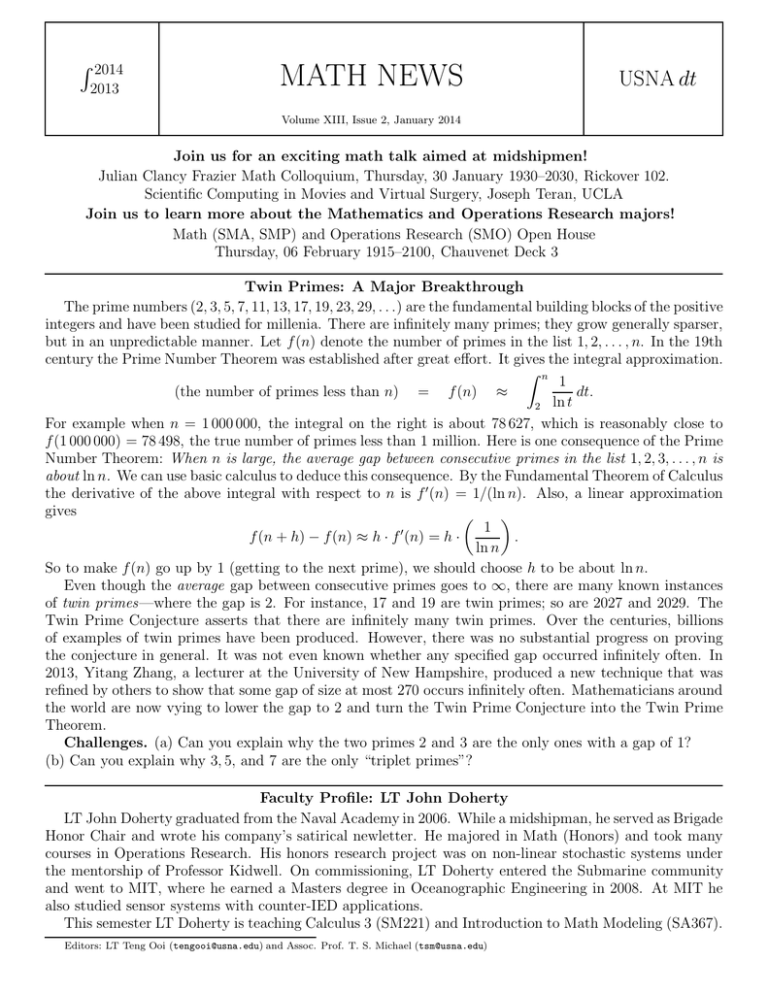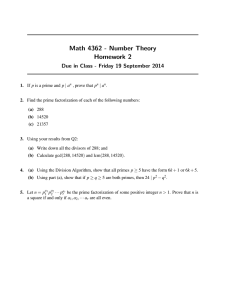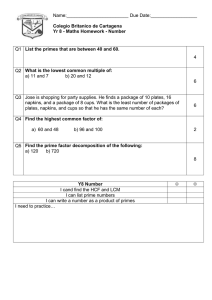MATH NEWS R dt USNA
advertisement

R 2014 2013 MATH NEWS USNA dt Volume XIII, Issue 2, January 2014 Join us for an exciting math talk aimed at midshipmen! Julian Clancy Frazier Math Colloquium, Thursday, 30 January 1930–2030, Rickover 102. Scientific Computing in Movies and Virtual Surgery, Joseph Teran, UCLA Join us to learn more about the Mathematics and Operations Research majors! Math (SMA, SMP) and Operations Research (SMO) Open House Thursday, 06 February 1915–2100, Chauvenet Deck 3 Twin Primes: A Major Breakthrough The prime numbers (2, 3, 5, 7, 11, 13, 17, 19, 23, 29, . . .) are the fundamental building blocks of the positive integers and have been studied for millenia. There are infinitely many primes; they grow generally sparser, but in an unpredictable manner. Let f(n) denote the number of primes in the list 1, 2, . . . , n. In the 19th century the Prime Number Theorem was established after great effort. It gives the integral approximation. Z n 1 dt. (the number of primes less than n) = f(n) ≈ 2 ln t For example when n = 1 000 000, the integral on the right is about 78 627, which is reasonably close to f(1 000 000) = 78 498, the true number of primes less than 1 million. Here is one consequence of the Prime Number Theorem: When n is large, the average gap between consecutive primes in the list 1, 2, 3, . . . , n is about ln n. We can use basic calculus to deduce this consequence. By the Fundamental Theorem of Calculus the derivative of the above integral with respect to n is f 0 (n) = 1/(ln n). Also, a linear approximation gives 1 0 f(n + h) − f(n) ≈ h · f (n) = h · . ln n So to make f(n) go up by 1 (getting to the next prime), we should choose h to be about ln n. Even though the average gap between consecutive primes goes to ∞, there are many known instances of twin primes—where the gap is 2. For instance, 17 and 19 are twin primes; so are 2027 and 2029. The Twin Prime Conjecture asserts that there are infinitely many twin primes. Over the centuries, billions of examples of twin primes have been produced. However, there was no substantial progress on proving the conjecture in general. It was not even known whether any specified gap occurred infinitely often. In 2013, Yitang Zhang, a lecturer at the University of New Hampshire, produced a new technique that was refined by others to show that some gap of size at most 270 occurs infinitely often. Mathematicians around the world are now vying to lower the gap to 2 and turn the Twin Prime Conjecture into the Twin Prime Theorem. Challenges. (a) Can you explain why the two primes 2 and 3 are the only ones with a gap of 1? (b) Can you explain why 3, 5, and 7 are the only “triplet primes”? Faculty Profile: LT John Doherty LT John Doherty graduated from the Naval Academy in 2006. While a midshipman, he served as Brigade Honor Chair and wrote his company’s satirical newletter. He majored in Math (Honors) and took many courses in Operations Research. His honors research project was on non-linear stochastic systems under the mentorship of Professor Kidwell. On commissioning, LT Doherty entered the Submarine community and went to MIT, where he earned a Masters degree in Oceanographic Engineering in 2008. At MIT he also studied sensor systems with counter-IED applications. This semester LT Doherty is teaching Calculus 3 (SM221) and Introduction to Math Modeling (SA367). Editors: LT Teng Ooi (tengooi@usna.edu) and Assoc. Prof. T. S. Michael (tsm@usna.edu)








